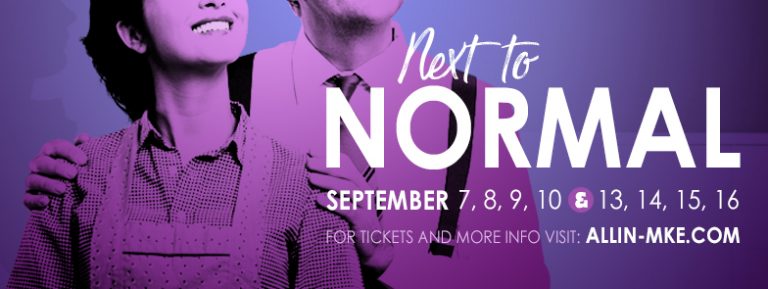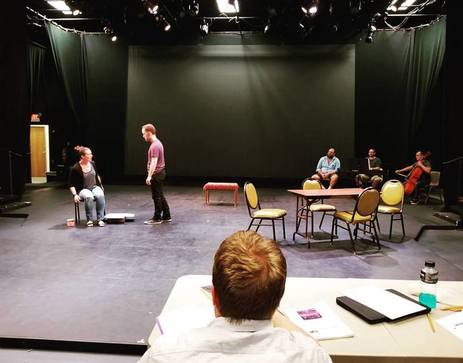|
Early next month, All In Productions brings the rock musical NEXT TO NORMAL to the stage of the Next Act Theatre. The story of a contemporary suburban family dealing with mental illness and so much else opens on an intimate stage. Director Tim Backes took some time to answer a few questions about the show. The American musical has been around for over 100 years. Modern musical theatre offers such a huge scope of different possible productions. Why did you choose NEXT TO NORMAL for your next production? When we were sitting down to discuss our 2017 season, it was right after the elections in November. We knew we wanted to have a single unifying theme for the season, and given the state of our country in the immediate aftermath of the election and the amount of polarization and conflict in our society, we wanted to aim for a theme and for shows that would bring people together. There’s a tendency for theater companies and artists to want to make big, bold political or ideological statements with their work, but we didn’t want anything divisive. So we settled on the theme “Let’s Talk” in the hopes of doing shows that would create positive, constructive conversations about important issues rather than adding to the division. Next to Normal fit the theme perfectly. I would hope we can all agree that there needs to be more of a light shined on mental illness in the United States. There is still so much we do not know about the human brain, and as a result, there is such a stigma attached to conditions like bipolar disorder and depression. The show does a wonderful job of treating bipolar disorder responsibly, showing Diana as being a strong, capable woman in many regards while also not holding back on demonstrating the horrible ways in which the illness affects not only her, but her family. The show also fit what we were looking for logistically. We wanted to do a musical with a smaller cast that we thought would be a popular selection, having opted for shows people might not know as well over the last couple years. Next to Normal is a hit with theatergoers of all backgrounds for how genuine its characters are, how touching its story is, and yes, the great music. NEXT TO NORMAL is a delicate balance. There’s some really intense music balanced against harrowingly nuanced treatment of perilously heavy themes like drug abuse, mental illness and modern psychiatry. The productions that I’ve seen in the past have managed to tread a very precise path between the staginess of theatrical musical and the delicate nature of human drama. How are you balancing the musical and dramatic angles of the production? Great question. It’s extremely difficult. If there is any element of campiness to the show, particularly with regard to the way we treat mental illness, then the show not only loses its effectiveness, but becomes disrespectful. At the same time, we can’t be so heavy-handed with the serious nature of some of the themes that we lose sight of the moments of levity and hope that are sprinkled throughout the show. If I had to pick one word to describe Next to Normal it would be “human,” and humans are incredibly complex creatures. The biggest danger with Next to Normal is that the powerful rock music can become distracting for both the actor and the viewer. It’s easy for a production of the show to lose sight of its character-driven nature and turn into a belt-off, but that really detracts from the intimacy of the show. For me, the most important thing was taking the time early in the rehearsal process to get into the headspace of the characters and to discuss bipolar disorder and the most prevalent themes in the show. I met individually with each cast member to closely analyze the songs, the feelings of the characters and the stakes of each scene, all before we blocked a single scene. I wanted the cast to have as much time as possible to put themselves into the positions of their respective characters and really think through how Diana’s illness was affecting theme, far beyond any of the ways written into the script. We were also extremely fortunate to have Dr. Anthony Meyer, the former head of Aurora Psych, come in and give a talk to our cast and production team about his decades of experience in treating patients with bipolar disorder. He had some incredible insights, and it really set the tone for the rest of our rehearsal process. You recently posted an image from your first time in the theatre. It’s the back of your head. A few chairs. A few actors. A cello. It’s cool seeing an image of a rehearsal literally from the director’s perspective. I would imagine that there’s a lot going on for you during a rehearsal that wouldn’t be visible from any picture. How much of the total production are you seeing in your head when you’re rehearsing at the venue for the first time? Is there a point early on when you have to start fusing your internal conception of the show with the space you’ll be performing in?
It was a really amazing feeling to finally be able to get into the Next Act space and get a feel for the spacing and the actual pictures the audience is going to be seeing. Even without any of our set pieces in place yet, it just feels so much more like a real show when you get in there. So from a director’s standpoint, yeah—suddenly you are seeing everything at once with so much more clarity, and it’s a whole lot to process. You can suddenly get a better sense of how lighting will work in certain scenes, or whether you might need to move a certain set piece a little bit to improve sightlines. The conception of the show has to be present throughout the entire process. We knew we wanted to create a more intimate, scaled back version of the show, getting rid of the “rock concert” aura that the Broadway production and many other productions tend to use and opting for building an actual, simple home instead. That guided everything we did, long before we even had a cast. But when blocking (and acting), it’s so hard to get an accurate sense of the pictures you are creating for the audience when you’re not in the actual space, especially a space as intimate and unique as Next Act. The Next Act Theatre’s thrust stage poses interesting challenges to any production. The thrust stage can be difficult to work with. I remember Robby McGhee doing a really good job of filling the space from all angles with his production of The Wild Party for All-In. What’s it like directing a show for the Next Act Theatre space? Having three sides of the stage surrounded by audience is a tremendous challenge. As I said in the last question, you can’t really get an accurate sense of what you’re dealing with until you really see the blocking for the first time in the space. We’ve had to make a few adjustments to ensure our sightlines were correct and that we’re giving each side of the stage enough love. The tough part is that you have to come to peace with the fact that not every single person in the audience will have a clear shot at every actor’s face at all times, just by the nature of how the stage is set up and by how many times in the script there are split scenes happening. But I think we have done a good job of being conscious of each side of the audience’s perspective of the action. Despite these challenges, I have to say this is one of my favorite places in Milwaukee to see and do a show. The audience is right up close and personal to the stage. Considering how much of the focus for our production of this show has been on investigating the internal struggles of each character, the layout of the theater puts the audience right into those characters’ world, and I think it is going to make what’s already an extremely powerful show that much more emotional and affecting. You’re really good about posting on social media. It’s cool to see a timeline of the show: June 29: auditions. July 2: Official announcement of the cast. July 8: official announcement on Facebook. July 24: first read through. August 24: designer run. I love the ongoing background on the production being visible on social media. Do you feel as though the increased behind-the-scenes visibility increases the pressure on a production? There may be some element of that, but I think using social media like that gets people more invested in the journey we are taking with the show and more interested in coming out and seeing the end result of the process they’ve been following. Honestly, most of the pressure I feel for this show is pressure I put on myself. I’m directing a show a lot of people know and love with a company that has been quite fortunate to receive some very positive feedback to our shows in our first several seasons. I came into the process knowing All In Productions had a growing reputation in our theater community that I needed to not just uphold, but expand, and I do not take that responsibility lightly at all. Add in the fact that I’m a first-time director, and it’s quite a lot to handle sometimes. Fortunately, I’ve been blessed with an incredible support system throughout the process. Almost my entire production team has worked with All In Productions before and was able to hit the ground running because they know how we do things. The AIP board has been very supportive. Robby McGhee is serving as my assistant director for the show, and he’s been an incredible mentor, partner and sounding board. And I can’t say enough great things about the cast. These are people who really care about their roles and this show. For many of them, they’re taking on dream roles, and you can see every day how they are not taking this opportunity for granted. I’m so proud of the work they’ve put in. As I write this, you’re only a couple of weeks away from opening. What are you learning about the show now that everything is snapping together less than 14 days from opening night? We have really been able to make the adjustment from “let’s work this song and make sure we have the blocking right” to “let’s really dive into these characters and this story and see what we can discover.” It’s been fun watching the cast make discoveries about their roles and dissect each song, and I’m really excited to see how their understanding of their parts and of the overall humanity of the show continues to deepen over the final couple weeks we have before we open, and how that manifests itself in the choices they make on stage. All In Productions' staging of Next to Normal runs Sep. 7 – 16 at the Next Act Theatre space on 255 S. Water St. For ticket reservations and more, visit All In online.
0 Comments
Leave a Reply. |
Russ BickerstaffArchives
April 2024
Categories |


 RSS Feed
RSS Feed
